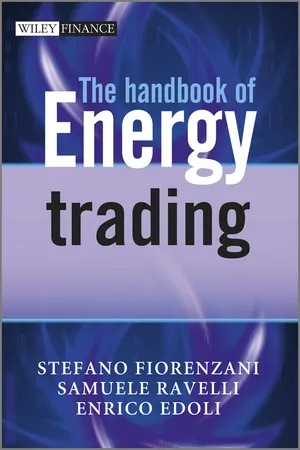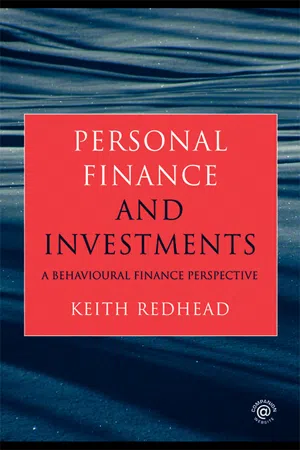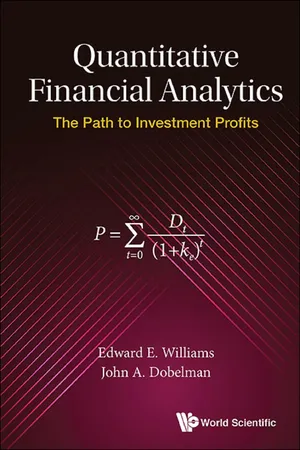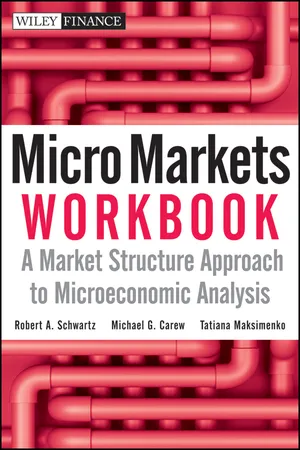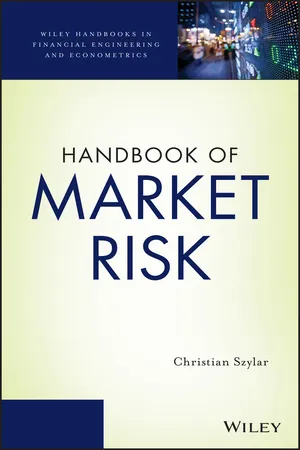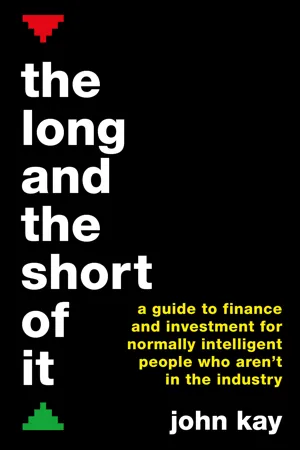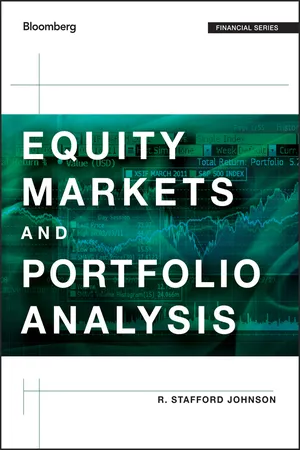Economics
Market Efficiency
Market efficiency refers to the degree to which prices in a market reflect all available information. In an efficient market, prices quickly adjust to new information, making it difficult for investors to consistently outperform the market. This concept is important in understanding the allocation of resources and the functioning of financial markets.
Written by Perlego with AI-assistance
Related key terms
11 Key excerpts on "Market Efficiency"
- eBook - ePub
Understanding Investments
Theories and Strategies
- Nikiforos T. Laopodis(Author)
- 2020(Publication Date)
- Routledge(Publisher)
Since the 2008/9 Great Recession, a number of market analysts have suggested that individual investors should not try to time the market or pick stocks based on past performance, or even conduct fundamental analysis, but instead they should invest in stock index funds. This recommendation is based on a belief that Market Efficiency is reflected in stock and other asset prices as well as indexes. In addition, with the widespread use of technology (for sharing of information on social media with devices like smartphones), markets have become even more efficient, because new information arrives more rapidly and disseminates widely and thus levels the trading field for all.Now, let us turn to the three different forms of Market Efficiency to see how efficient the stock market is.9.2.2 The forms of Market Efficiency
Investors look for pricing inefficiencies because these would open up profit opportunities. Such profit opportunities in investment assets can be categorized into three forms of pricing efficiency based on the amount of all available information investors have and use in their asset valuations. All three forms imply that excess profits can be made only by chance (or luck) and unrelated to available (public or private) information.Weak form
This type of Market Efficiency assumes that an investor cannot earn excess profits by using all past information on an asset because that information is already reflected in the current price of the asset. Thus any historical market data (price and trading volume) on the asset are incorporated into the current price of the asset and should have no value in predicting the asset’s price in the future. Past data are now part of public information and useless. If such data in the past had any profit value, then that value would have been exploited at that time and no significant residual value would remain in the present.Semi-strong form
The semi-strong type of Market Efficiency states that, in addition to all past information, all currently publicly available information should already be reflected in the current price of the asset. Some examples of such public information on a firm would be its earnings forecasts, quality of management, financing status, and the like. The instant such information is released in the market the asset’s prices should immediately adjust to reflect that information. Such information can be obtained either from the firms’ webpages (for free) or from your broker (for a fee). Therefore, if all investors can access that information, then no one should be able to make abnormal profits. - Lukasz Snopek(Author)
- 2012(Publication Date)
- Wiley(Publisher)
Part III The MarketOnce familiar with the investment universe and the various risks associated with each asset class as defined above, investors will need to study the market, which sets the price of these different assets.However, they would be forgiven for wondering whether this price fully reflects all available information, and if it can indeed be regarded as “fair”. This takes us to the famous notion of Market Efficiency.Passage contains an image Chapter 6 Market Efficiency
According to the efficient market hypothesis, the price given by the market is always the fair price and fully reflects all available information .“A market in which all available information is immediately reflected in the price of securities offers no opportunity for arbitrage. It is therefore difficult to beat the market with any consistency, making passive management the best choice.”1- eBook - ePub
Scientific Method
How Science Works, Fails to Work, and Pretends to Work
- John Staddon(Author)
- 2017(Publication Date)
- Routledge(Publisher)
claim , that the market cannot be beaten. Above-average profits cannot be made on the basis of publicly available information. But let’s take the model idea seriously and see where it leads us.Just how is Market Efficiency defined? Fama writes: “A market in which prices always ‘fully reflect’ available information is called ‘efficient.’” This is the efficient market hypothesis. Fama calls it a “simple statement,” but that is the one thing it is not. The definition differs from the way efficiency is used in physical science in several ways. First, it is not a ratio; second, it depends on something called information which can itself be defined in several ways; and finally, it doesn’t yield a number. The terms ‘available’ and ‘fully reflect’ are also far from obvious.Fama is aware that his ‘simple’ definition is in fact quite opaque:The definitional statement that in an efficient market prices ‘fully reflect’ available information is so general that it has no empirically testable implications. To make the model testable, the process of price formation must be specified in more detail. In essence we must define somewhat more exactly what is meant by the term ‘fully reflect.’4Well said. So, efficiency, which seems like a sensible and certainly a desirable property, depends on our understanding of exactly how prices are determined. In Fama’s own words: “We can’t test whether the market does what it is supposed to do unless we specify what it is supposed to do. In other words, we need an asset pricing model … that specifies the characteristics of rational expected asset returns in a market equilibrium…” I will return in a moment to the phrase “supposed to do” (according to whom? By what criteria? Etc.)The term efficiency was in wide use before Fama’s influential theory.5 But efficiency as defined by the EMH is tricky, since it can only be evaluated by comparing actual market behavior with a model for how markets should behave. Let us accept for the moment that there are market equilibria, although I argued in Chapter 5 that they cannot be taken for granted. The price of something depends on how a thing is valued. Fama is apparently willing to ignore Jacob Viner’s stricture against exploring the ‘origin of value.’ Fama is also breaking the prejudice against forecasting - eBook - ePub
- Stefano Fiorenzani, Samuele Ravelli, Enrico Edoli(Authors)
- 2011(Publication Date)
- Wiley(Publisher)
Chapter 1 Energy Markets as Efficient Markets 1.1 The “Efficient Market Hypothesis”Are energy markets efficient markets? In what sense can a commodity market be considered efficient? And what are the trading implications of Market Efficiency? These are the questions we would like to answer in this introductory chapter. The third question, in particular, has a strong impact on the overall meaning of the book, but obviously, before discussing the trading implications of Market Efficiency we need to define the concept formally and to try to understand if energy markets can be considered efficient in some sense.The theoretical origins of the Efficient Markets Hypothesis (EMH) are connected with pioneering studies of modern financial economics. The first formal definition and in depth analysis must surely refer to the studies of Roberts (1967) and Fama (1970). Whenever we say that a market, a financial market particularly, is efficient we basically refer to efficiency in the informational sense. In fact, in a competitive market, asset prices dynamically reflect relevant information flows and consequently a certain market is more informationally efficient if it is able to reflect more relevant information in its asset prices. Information is thus relevant if it can predict future price dynamics. According to Fama's original definition, a capital market is said to be efficient with respect to a certain information set if security prices would be unaffected by revealing that information to all market participants. Hence, the description of the information set is the base for the definition of Market Efficiency.The classic taxonomy of the information set exposed by Roberts (1967) characterizes three different forms of Market Efficiency: weak, semistrong and strong.In weak form Market Efficiency the information set considered includes only the history of prices themselves. If the market we are considering is efficient in the weak form, revealing the whole history of security prices to market participants wouldn't impact their behaviour in the market. In other words, future prices cannot be predicted by analyzing prices from the past. Under this framework, price realizations are time independent of each other. Knowing last price realization or the whole history of prices wouldn't change the ability to predict future prices. This form of Market Efficiency has strong mathematical and trading implications and will be discussed throughout the chapter. - eBook - ePub
Personal Finance and Investments
A Behavioural Finance Perspective
- Keith Redhead(Author)
- 2008(Publication Date)
- Routledge(Publisher)
Market EfficiencyPassage contains an image
Chapter 23Market Efficiency: Concepts and weak form evidence
The objective of this chapter is to provide knowledge of:OBJECTIVE- The concepts of weak, semi-strong, and strong form informational efficiency.
- Evidence of arbitrage failures.
- Empirical evidence on the weak form of the efficient market hypothesis.
- Evidence on overshooting and mean reversion.
- Evidence on momentum and contrarian strategies.
- The implications of Market Efficiency for investment analysis.
TYPES OF EFFICIENCY
Market Efficiency can be divided into three types: allocative efficiency, operational efficiency, and informational efficiency. Allocative efficiency is concerned with whether funds are directed to their most productive uses. This is mainly a primary market issue; the primary market being the market in which borrowers issue securities and receive payment from the initial investors (the word ‘borrowers’ here includes companies that raise money by issuing shares although, strictly speaking, share issuance is not borrowing). Allocative efficiency is concerned with the issue of which borrowers receive the finance. An allocatively efficient market is one in which the available funds go to the borrowers who will make the most productive use of them. Allocative efficiency is not the main concern here. However, it is important to be aware that allocative efficiency is dependent on operational and informational efficiency.Allocative efficiency is dependent upon securities (shares and bonds) being accurately priced. Accurate pricing requires informational efficiency. If securities are not accurately priced, investors could direct their money to uses that are not the most productive. For example during 1999 and early 2000 shares in Internet-related companies were seriously overpriced. For those people establishing Internet-related companies, the proceeds from share sales heavily exceeded the costs of establishing the companies. So there was a great incentive to set up Internet-related companies. Too many Internet-related companies were created and most of them subsequently failed. The overpricing of shares issued by Internet-related companies had caused too much money to be invested in such companies. Much of this money could have been invested more productively elsewhere. - eBook - ePub
Quantitative Financial Analytics
The Path to Investment Profits
- Edward E Williams, John A Dobelman;;;(Authors)
- 2017(Publication Date)
- WSPC(Publisher)
Chapter 9 . Efficiency is a necessary condition for equilibrium, but it is not altogether sufficient; we shall return to this point in the latter part of the chapter.It will be recalled, that, even in a world of perfect certainty, prices of securities could be expected to change over time as long as the income stream was not instantaneous and constant. Indeed, price change would be necessary in such a case to cause the expected return for each holding period to be obtained, that is,orIn a world of less-than-perfect certainty, changes in expected income or the required rate of return (caused, in turn, by changes in the pure rate or the perceived risk of the issue) could also cause the prices of securities to change over time. It is argued, however, that only the availability of new information or better analysis of already available information should cause the expectations regarding income, risk, and interest rates to change and, thus, prices to change for these reasons. If it may be assumed that: (1) all relevant information is available to all market participants; (2) any new information is spread and assimilated immediately; and (3) vast numbers of market participants employ the most sophisticated analytical techniques, then the securities market may be viewed as a “fair game” where:The above merely states that the expected price of a security in period one given the information available in period zero (assuming all dividends or interests are reinvested) is equal to the price in period zero times one plus the expected rate of return, given available information. (This formula and material in this section are discussed in more detail in Eugene F. Fama (1970). This hypothesis also implies that (1) the excess market value of a security or (2) the excess expected return to be earned by holding the security both have, given available information, an expected value of zero. - eBook - ePub
Micro Markets Workbook
A Market Structure Approach to Microeconomic Analysis
- Robert A. Schwartz, Michael G. Carew, Tatiana Maksimenko(Authors)
- 2010(Publication Date)
- Wiley(Publisher)
Important formulations (such as the Capital Asset Pricing Model) are based on the assumption that expectations are homogeneous. In real-world markets, however, divergent expectations is the name of the game, and this paradigm shift has major implications (concerning, for instance, how equilibrium prices are discovered in a micro market). 5. Informational efficiency is a multidimensional concept. We consider the efficiency with which investors exploit existing information, the efficiency with which they pursue information-gathering activities, the informational accuracy of equilibrium prices, and the dynamic efficiency of information dissemination. These are not simple matters. A lot is required for a market to be informationally efficient. 6. As we turn next to a test of Market Efficiency, we focus on equity markets and on informational efficiency. How does one know, you might wonder, whether all existing information is fully reflected in stock prices? It turns out that there is a very clever way to infer whether prices are being efficiently set. The way involves the Efficient Market Hypothesis (EMH). The hypothesis is that information is fully reflected in stock prices, and the best-known test of the EMH is whether stock prices follow random walks. 7. Here is the logic behind the random-walk tests: If all information is reflected in a stock’s price, then there is no way to predict how the stock’s price will change in the future, because we would have no way of knowing what the new information will be. But what if future stock price changes are correlated with past stock price changes? With a correlation pattern, future price changes could be predicted from past price changes. But predictability itself is information, and acting on this information eliminates the very correlation patterns that it is based on. Once any correlation message is incorporated in price, the correlation patterns can no longer exist and price must be following a random walk. 8 - eBook - ePub
- Christian Szylar(Author)
- 2013(Publication Date)
- Wiley(Publisher)
lucky.Fama identified three distinct levels (or “strengths”) at which a market might actually be efficient.An efficient market is defined as a market where there are large numbers of rational, profit maximisers actively competing, with each trying to predict future market values of individual securities, and where important current information is almost freely available to all participants. In an efficient market, competition among the many intelligent participants leads to a situation where, at any point in time, actual prices of individual securities already reflect the effects of information based both on events that have already occurred and on events which, as of now, the market expects to take place in the future. In other words, in an efficient market at any point in time the actual price of a security will be a good estimate of its intrinsic value. (Fama, 1970)2.2.1 Strong EMH
In its strongest form, the EMH says a market is efficient if all information relevant to the value of a share, whether or not generally available to existing or potential investors, is quickly and accurately reflected in the market price. For example, if the current market price is lower than the value justified by some piece of privately held information, the holders of that information will exploit the pricing anomaly by buying the shares. They will continue doing so until this excess demand for the shares has driven the price up to the level supported by their private information. At this point they will have no incentive to continue buying, so they will withdraw from the market and the price will stabilize at this new equilibrium level. This is called the strong-form EMH. It is the most satisfying and compelling form of EMH in a theoretical sense, but it suffers from one big drawback in practice. It is difficult to confirm empirically, because the necessary research would be unlikely to win the cooperation of the relevant section of the financial community—insider dealers. - eBook - ePub
The Long and the Short of It (International edition)
A guide to finance and investment for normally intelligent people who aren't in the industry
- John Kay(Author)
- 2016(Publication Date)
- Profile Books(Publisher)
The market is democratic in the sense that everyone is allowed to vote, but it is not a fair election. The weight given to your opinion depends on the amount of money you can put behind your vote. The votes of a large fund management group such as BlackRock or an investment bank such as Goldman Sachs count more than the votes of you and me. Perhaps this is as it should be. If you are really confident of your opinion, you can make that opinion count by putting a lot of money behind it. I shall describe how George Soros pulled off a spectacular coup by doing exactly that.The concept of the market as voting machine provides a justification for my claim that every investor can access, without charge, all the expertise that the financial services industry can bring to bear. That idea leads to the efficient market hypothesis. If the market price were an average of informed estimates of fundamental value, markets would be efficient not only in the narrow technical sense that all available information is in the price but also in a broader sense – market prices provide signals that guide the efficient allocation of investment funds.In this chapter I’ll focus on the narrower interpretation of Market Efficiency, the one relevant to investors. But there are three sub-interpretations, because there are three variants of the efficient market hypothesis involving progressively more demanding assumptions:- the weak form – past movements of prices convey no information about future price movements;
- the semi-strong form – all public information about securities is already reflected in their price; and
- the strong form – everything that could be known about securities is already reflected in their price.
Louis Bachelier, the little-honoured Frenchman whose PhD thesis on ‘The Theory of Speculation’ proved to be the foundation of finance theory, discovered that the data he compiled about stock price movements resembled the observations of natural processes, such as the movement of small particles suspended in a fluid. Physicists call this behaviour Brownian motion. Financial economists, more engagingly, employ the term ‘random walk’. A random walk is directionless. Every step is independent of every previous step and just as likely to be in one direction as in another. All three versions of the efficient market hypothesis claim that securities prices will follow a random walk. The random walk is a mathematical concept inseparable from the EMH. - eBook - ePub
The Long and the Short of It
A guide to finance and investment for normally intelligent people who aren't in the industry
- John Kay(Author)
- 2016(Publication Date)
- Profile Books(Publisher)
The market is democratic in the sense that everyone is allowed to vote, but it is not a fair election. The weight given to your opinion depends on the amount of money you can put behind your vote. The votes of a large fund management group such as BlackRock or an investment bank such as Goldman Sachs count more than the votes of you and me. Perhaps this is as it should be. If you are really confident of your opinion, you can make that opinion count by putting a lot of money behind it. I shall describe how George Soros pulled a spectacular coup by doing exactly that.The concept of the market as a voting machine provides a justification for my claim that every investor can access, without charge, all the expertise that the financial services industry can bring to bear. That idea leads to the efficient market hypothesis. If the market price were an average of informed estimates of fundamental value, markets would be efficient, not only in the narrow technical sense that all available information is in the price but also in a broader sense – that market prices provide signals that guide the efficient allocation of investment funds.In this chapter I’ll focus on the narrower interpretation of Market Efficiency, the one relevant to investors. But there are three sub-interpretations, because there are three variants of the efficient market hypothesis, involving progressively more demanding assumptions:- the weak form – past movements of prices convey no information about future price movements;
- the semi-strong form – all public information about securities is already reflected in their price; and
- the strong form – everything that could be known about securities is already reflected in their price.
Louis Bachelier, the little-honoured Frenchman whose PhD thesis on ‘The Theory of Speculation’ proved to be the foundation of finance theory, discovered that his data resembled the observations of natural processes, such as the movement of small particles suspended in a fluid. Physicists call this behaviour Brownian motion. Financial economists, more engagingly, employ the term ‘random walk’. A random walk is directionless. Every step is independent of every previous step and just as likely to be in one direction as in another. All three versions of the efficient market hypothesis claim that securities prices will follow a random walk. The random walk is a mathematical concept inseparable from the EMH. - eBook - ePub
- R. Stafford Johnson(Author)
- 2014(Publication Date)
- Bloomberg Press(Publisher)
0 ).Scenario 3
Suppose again that the market consists of a sufficient number of fundamentalists and technicians that the price increases quickly. This time suppose an investment group specializing in energy stocks is more adept at analyzing the news than the average investor and determines that the equilibrium price is $75. With this ability, the group is able to identify its trading strategy of buying below $75. With the stock fluctuating for several days after the announcement, suppose the investment firm buys at $72, thus earning a return above the new equilibrium level. In this scenario, the efficient market hypothesis would hold in the weak and semi-strong forms (Hw 0 and Hss 0 ), but not the strong form: Hs 0 (2) does not hold.Scenario 4
Suppose this time the market is characterized by fundamentalists who are all equally adept at analyzing fundamental information. Like scenario 2, the fundamentalists again would be able to quickly push the price to its equilibrium level at $75, with a smaller accompanying variability. Unlike scenario 3, however, no investment group on average would be able to earn abnormal returns. Suppose in this case that the company's geologist, knowledgeable regarding the new reserve estimates, buys the stock several days before the announcement at $50 and then sells it sometime later at $75 when the information is fully reflected in the price. We have an insider who is able to earn abnormal return while fundamentalists and technicians are not. The efficient market hypothesis would hold in the weak and semi-strong forms (Hw 0 and Hss 0 ), but only part of the strong form: Hs 0
Index pages curate the most relevant extracts from our library of academic textbooks. They’ve been created using an in-house natural language model (NLM), each adding context and meaning to key research topics.



